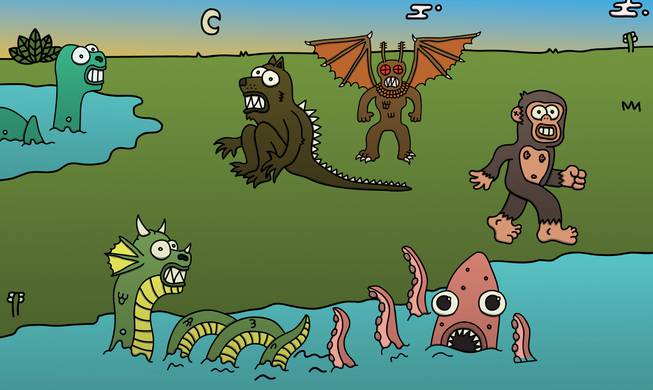
Illustrations by Craig Winzer
Friday, June 28, 2019 | 2 a.m.
Sometimes we see the things that go bump in the night, sometimes we don’t. But does that mean they don’t exist? For cryptozoologists, pondering the existence of mysterious creatures is a modus operandi.
Searching for creatures that actually may not walk the earth seems like a fruitless exercise, but as long as cryptids lurk in the shadows of our imaginations, cryptozoologists will go looking for them.
What is cryptozoology?
Cryptozoology is the study of hidden animals. The word was invented by Ivan T. Sanderson in the 1940s, when writing about sea serpents and was popularized by zoologist Dr. Bernard Heuvelmans, who penned On the Track of Unknown Animals in the 1950s. Heuvelmans became known as the father of cryptozoology.
A cryptid is an elusive animal that a cryptozoologist seeks and is either an unknown species or a species thought to be extinct that survived and is awaiting rediscovery. While that may seem far-fetched, consider the platypus, which scientists believed to be a hoax when it was first discovered in the 1700s. The venomous, egg-laying mammal with the bill of a duck, the tail of a beaver, and the webbed-feet of an otter stretched the boundaries of their imagination.
Loch Ness Monster
• Alleged range: Loch Ness, Scotland
• Description: A 6- to 30-foot-long serpentine, with a horse-like head, thick body, broad flippers, long tail, and one to three humps on its back
The legendary Nessie is one of the most well-known and well-loved cryptids. Her legend began in the first century AD, when invading Romans left stone carvings of a strange beast with flippers and a long neck. Written accounts surfaced in the sixth century, when an Irish monk named Saint Columba allegedly walked into the lake to “convert” a man-eating monster dwelling there into a nice monster. Through the centuries, hundreds have claimed to have spotted Nessie.
Tahoe Tessie
• Alleged range: Lake Tahoe
• Description: Serpentine lake monster 15-80 feet long
Nevada shares its very own cryptid with California beneath the shores of Lake Tahoe. Under Cave Rock there allegedly lives a monster named Tahoe Tessie, whose sightings date back to the Washoe and Paiute tribes. In 1959, off-duty police officer Mickey Daniels told the Los Angeles Times that he saw a huge wake from an underwater creature while he was fishing. Twenty years later, witnesses claimed they saw an enormous serpent as thick as a telephone pole hunting a school of trout. Sightings of Tahoe Tessie have been reported as recently as 2010.
Kraken
• Alleged range: Scandinavian seas
Not so much a legend?
In 2004, a research team discovered definitive proof that giant squids exist, capturing images near Japan. They grow to 34-44 feet with eyes that are a foot in diameter. Their beaks are large enough to swallow a basketball in one gulp.
• Description: Monstrous cephalopod. Think: an oversized squid or octopus 40-50 feet long
A sea monster from Scandinavian sagas, the Kraken is a massive cephalopod known for dragging ships and their sailors to their doom.
The creature first made an appearance in the tales of Iceland’s Örvar-Oddr, a celebrated hero whose adventures were recorded in the early 13th century. In one saga, he and his shipmates encounter a “hafgufa,” now widely considered to be the enigmatic Kraken.
“[T]he hafgufa is the hugest monster in the sea. It is the nature of this creature to swallow men and ships, and even whales and everything else within reach. It stays submerged for days, then rears its head and nostrils above surface and stays that way at least until the change of tide,” the story of Örvar-Oddr goes.
Chupacabra
Alleged range: Central America, Mexico, Puerto Rico, southwestern U.S.
Description: Bipedal, lizard-like creature 3-4 feet long with a dog face, spiny back, red eyes and large fangs.
The stuff of legend in many Hispanic communities, El Chupacabra, or the Goat Sucker, is a vampiric lizard creature with an affinity for farm animals. The monsters allegedly hunt goats and chickens, draining them of their blood with long, sharp fangs. There have been many sightings, and several farmers claim to have killed one. Upon closer investigation, however, it often turns out the vanquished creature is a coyote with terrible mange.
Mothman
• Alleged range: Point Pleasant, West Virginia
• Description: Man-shaped creature 6-7 feet tall with glowing red eyes and huge, bat-like wings
The years 1966-67 were a busy, mysterious time in Point Pleasant, West Virginia. Multiple newspapers throughout the region reported dozens of sightings of a red-eyed winged monster, towering at about 7 feet with a wingspan of more than 12 feet. The “man-sized bird … creature … something” as the Point Pleasant Register dubbed it, could fly more than 100 mph. It was thought to be a balloon, a UFO, plane and even a sandhill crane, but the reports ended with the great Silver Bridge disaster on December 15, 1967. During rush-hour traffic, the bridge spanning the Ohio River between Gallipolis, Ohio, and Point Pleasant suddenly collapsed, sending 46 people to their deaths. Did the Mothman come to Point Pleasant as a portent of doom, or did he bring disaster to the town?
Bigfoot / Sasquatch / Yeti
• Alleged range: Worldwide
• Description: Giant ape man, 7-9 feet tall, who is smelly and shy
With the exception of Antarctica, every continent boasts tales of a wild man. The creature takes on names such as Bigfoot, Sasquatch, Swamp Ape and Windigo in North America, Yeti in the Himalayas, Alma in Mongolia, or Yowie in Australia, but its description is more-or-less the same: an elusive upright ape-human, ranging from gorilla gray to pure white, depending on habitat. There have been casts made from footprints, sightings, photographs and videos through the years but no proof in the form of DNA, hair, blood or bones.
This story originally appeared in the Las Vegas Weekly.
